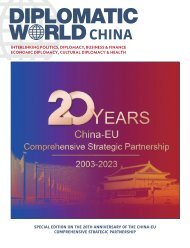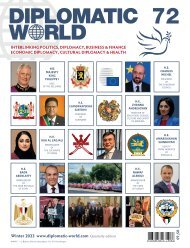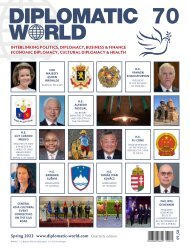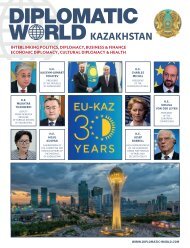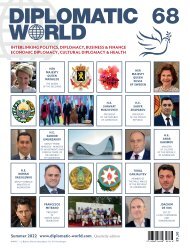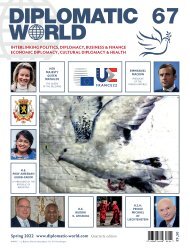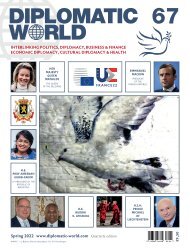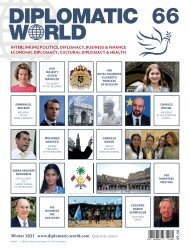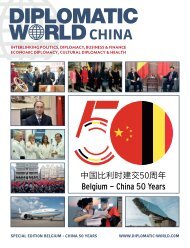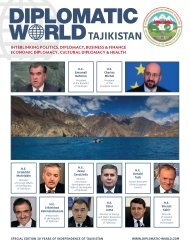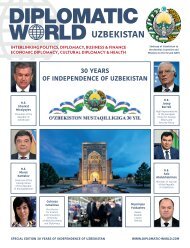Diplomatic World_69
You also want an ePaper? Increase the reach of your titles
YUMPU automatically turns print PDFs into web optimized ePapers that Google loves.
THE DIVINE RAPHAEL<br />
Univ. Prof. Dr. Dr. h.c. Jan DE MAERE<br />
Giorgio Vasari opens his biography about the Italian Renaissance<br />
painter and architect, the ‘divine’ Raphael (1483-1520), by<br />
describing his multifarious wide-ranging talents and astonishing<br />
achievement:’ The liberality with which Heaven now and again<br />
unites in one person the inexhaustible riches of its treasures and<br />
all those graces and rare gifts which are usually shared among<br />
many over a long period, is seen in Raphael Sanzio of Urbino’.<br />
At the time, such a genial versatility was not uncommon, but his<br />
eye for the most talented collaborators and craftsmen to follow<br />
his designs was unerringly flawless and underpinned his astonishing<br />
organized productivity. His talent for delegation of creation<br />
and quality control in his studio guaranteed its exceptional varied<br />
output. He was a collector, an antiquarian, the superintendent<br />
of Rome’s antiquities, imagining the graphic reconstruction of<br />
Ancient Rome. Without the Roman experience, Raphael would<br />
not have become the revered figure who came to dominate<br />
centuries of Western art.<br />
came the hero of the Poussinists, who believed, as Raphael did,<br />
in the Platonic idea of the existence of ‘a mind-born ideal form<br />
related to a higher level of understanding’, seen as a shadow of<br />
the ‘anima’ (Plato, Allegory of the Cave). Therefore, they considered<br />
colour only as a decorative addition to ‘disegno’, lines<br />
to depict ideal form. Charles Le Brun was their leader. His hero<br />
was Raphael and in the same line of thought, the syphilis ridden<br />
Nicolas Poussin (1594-1665), whose stoical-intellectual work<br />
exemplified this philosophy, based on the ideal of classical Form<br />
in Antiquity. Poussin’s cold approach contrasted strongly with the<br />
fine sensibility and delicate intimacy of Raphael’s series of ‘Virgin<br />
and Child’, as a feminine ideal of grace and beauty in the line of<br />
these in Petrarch’s poems. Also, Jean-Auguste-Dominique Ingres<br />
(1780-1867) brought to the fore the abstract clarity of classical<br />
form in his ‘Vow of Louis XIII’ (1824, Musée Ingres, Montauban).<br />
Even if ‘disegno’ was the base of Raphael’s art, it was imbedded<br />
in his universal genius.<br />
La Donna Velata, detail, canvas 82 x 60,5 cm (c. 1513-14) © Palazzo Pitti inv 1912 n° 245<br />
HIS LEGACY<br />
The Rubenists believed that colour, not drawing, was superior as<br />
it was closer to nature. They prioritised the depiction of nature<br />
and strong emotional expression over the imitation of classical<br />
THE EXHIBITIONS<br />
towards his upbringing as the son of a court painter in Urbino.<br />
It addressed the different influences which shaped his style, his<br />
In a 20-year career, harnessed to a fierce ambition, he reshaped<br />
art. They argued that painting should deceive the eye and en-<br />
Two exhibitions shed new light on Raphael’s genius. One in<br />
admiration for artists such as Perugino, Masaccio, Donatello,<br />
Western art more than any other artist before and since. Raphael<br />
gage the senses of all. In the early 18th century, this had revolu-<br />
2020 braved the pandemic but it had to close after 4 days in the<br />
della Robia, and Leonardo (as we see in Raphael’s ‘Dame with<br />
himself is blameless for the dull sterility, often expressed in the<br />
tionary political connotations as their art addressed everybody’s<br />
Scuderia del Quirinale (Rome). It focused on the triumph of his<br />
a Unicorn’), and his talented roster of pupils working under his<br />
academic tradition by his followers over centuries.<br />
emotion and not only that of an elite. It challenged the idea that<br />
Roman years and was completed by an exhibition in the Galleria<br />
command. In London, the curators applied a strict timeline and<br />
had held sway since the Raphael’s time that painting, as an’ Ars<br />
dell’ Uffizi (Firenze) with a broader perspective. In Rome, the<br />
concentrated only on Raphael’s own creative design and the way<br />
Rubens and Raphael created unique, instantly recognisable<br />
liberalis’, could only be appreciated by the well-educated mind.<br />
exhibition opened with a life-size facsimile of Raphael’s tomb in<br />
how he delegated creation. From his youth on, he always made<br />
paintings. The two artists, separated from each other by a cen-<br />
the Pantheon, built with cutting-edge technologies and destined<br />
drawings for paintings by other artists and artisans. His well-<br />
tury, might not at first seem comparable, but both were analo-<br />
The debate was about whether it was acceptable to paint<br />
to find a home in Urbino”. It bears the inscription: “Here lies<br />
planned elegant drawings of exceptional quality and their con-<br />
gous thinkers and had comparable working methods and studio<br />
purely in order to give pleasure to the viewer without the nobler<br />
Raphael, by whom nature herself feared to be outdone while he<br />
nection with the final work, give a stunning insight in the complex<br />
organization. The different stages in both artists’ development<br />
purposes typical of a ‘history’ painting. In 1672, Charles Le<br />
lived, and when he died, feared that she herself would die”.<br />
mind of this all-time great.<br />
are a result of travel and exposure to novelty. Raphael’s career<br />
Brun, Chancellor of the French Academy, held the argument that<br />
can be seen in three geographical moves: Urbino/Siena/Perugia<br />
(1483-1504); Florence (1504-08); and finaly Rome (1508-20).<br />
Rubens’ work develops in a similar phases of travel, exposure<br />
“the function of colour is to satisfy the eyes, whereas drawing<br />
satisfies the mind.” Roger de Piles favoured the colourists in<br />
his 1673 Dialogue sur le Coloris (Dialogue on Colour), and his<br />
Another exhibition this summer in the National Gallery London,<br />
originally due in 2020, the fifth century anniversary of Raphael’s<br />
death, was rescheduled this year because of Covid-19. The<br />
LIFE & ART<br />
and appropriation. At each stage he studied the works of Titian,<br />
1677 Conversations sur la Peinture (Conversations on Painting).<br />
show places the artist’s visual thinking and conceptual processes<br />
Raphael was born Raffaello Sanzio on April 6, 1483, in Urbino,<br />
Veronese, Tintoretto, Elsheimer, Michelangelo, Raphael, Giulio<br />
It was an attack on everything the Academy stood for, including<br />
to the fore, and trace Raphael’s development from ‘primo pensie-<br />
Italy. He lost his mother, Magia di Battista Ciarla, at age 8 and<br />
Romano, Caravaggio and Annibale Carracci, and ancient sculp-<br />
its political functions in support of the King. Finally, the Rubenists<br />
ro’ to the final paintings, a survey of the artist’s entire career, his<br />
his father at 11 (1494). At the time, Urbino, in the Marche region<br />
ture. Both artists delegated some of their work but retained full<br />
won when Antoine Watteau’s ‘The Embarkation for Cythera’ was<br />
designs for others, and his studio organization.<br />
of eastern Italy, was a cultural centre that encouraged the Arts.<br />
control.<br />
accepted as his reception piece by the Academy in 1717. This<br />
Raphael’s father, Giovanni Santi (c. 1440/45-1494), was a court<br />
quarrel about ‘disegno’ and ‘colore’ caricatured Raphael’s<br />
Each exhibition in its own way illustrated the master’s complex<br />
painter to the highly cultured Duke of Urbino, Federigo da<br />
The century old debate, still ongoing ‘The quarrel for primacy<br />
‘Sapere Vivere’ and the complexity in design as well in colour<br />
talent. Since a lot of his work, such as fresco cycles and altar-<br />
Montefeltro. Giovanni taught the young Raphael basic painting<br />
of Form or Colour’ gives insight in the way different periods read<br />
of his supernatural grace and affability. His talent transformed<br />
pieces, is unmovable, a trip to Italy imposes itself as a stand-in<br />
techniques and exposed him to the principles of humanistic<br />
Raphael’s art, compared to what seems to be its opposite, Pieter<br />
replication of Antique sculpture in an innovation where everything<br />
for this void. In Rome, the exhibition explored Raphael’s career<br />
philosophy at the Duke of Urbino’s court.<br />
Paul Rubens. Two hundred years after Raphael’s death, he be-<br />
refers to everything. Raphael was design, colour and emotion.<br />
in reverse, from his burial, which impacted everybody in Europe,<br />
200 201





